How to Make Sweet Potato Noodles
This is a simple tutorial that will show you how to make Sweet Potato Noodles.
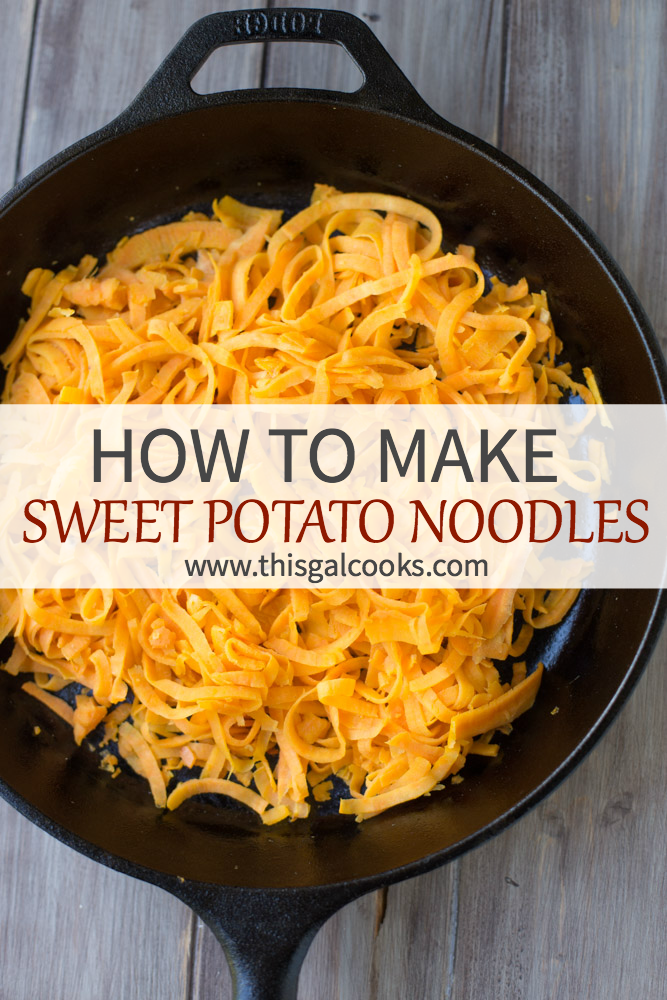
Sweet potato noodles are one of my favorite ways to shake up dinner without reaching for anything boxed or bland. They’re naturally gluten-free, full of flavor, and surprisingly easy to make once you know what tools to use and how to handle them in the skillet.
The first time I tried spiralizing a sweet potato, I was a little overconfident. I grabbed the biggest potato in the bin, jammed it into my little hand-held spiralizer, and ended up with more frustration than noodles. But after a few rounds of trial and error, I figured out how to make it work. Now it’s one of those prep techniques I keep coming back to, especially when I want a healthy base that holds up to hearty toppings like lentils, fried eggs, or spiced chicken.
This guide will show you exactly how to make sweet potato noodles from scratch, starting with what type of potato to buy and what spiralizer works best, all the way through to cooking, storing, and seasoning. I’ll also share my original tutorial below so you can follow the step-by-step instructions I’ve used for years.
Whether you’re here for a paleo-friendly dinner idea, a gluten-free alternative to pasta, or just curious about the spiralizer you bought on a whim, you’re in the right place.
Let’s get started with why sweet potato noodles are worth making in the first place.
Skip to Julie’s Special Recipe!
Why Sweet Potato Noodles Are So Popular
Sweet potatoes are all the rage right now, and understandably so. Not only do they boast great flavor, they’re packed with fiber, beta-caratone and micronutrients. They’re low on the glycemic index, making them a great paleo friendly food option.
Sweet potatoes can be prepared in many different ways, including baking, grilling or sautéing. Mash a baked sweet potato and use it in sweet potato casserole. Drizzle grilled sweet potatoes with olive oil and serve with grilled chicken. Saute diced sweet potatoes and serve with eggs for a healthy protein packed breakfast. Sweet potatoes can also be used to make gluten free sweet potato noodles.
Texture-wise, sweet potato noodles hold up better than zucchini noodles. They have just the right amount of starch to give you a satisfying bite, without turning watery or limp when cooked properly. That means they’re perfect for stir-fries, grain-free pasta bowls, breakfast skillets, and just about anything you’d normally serve with rice or pasta.
And if you’ve got picky eaters at home, these noodles are a sneaky way to introduce more vegetables without the usual resistance. Tossed in a little olive oil and seasoning, they’re naturally craveable and easy to customize with different flavors.
So whether you’re cooking for health reasons or just looking for a delicious new base for your favorite meals, sweet potato noodles offer versatility, nutrition, and great taste all in one simple dish.
Best Tools for Making Sweet Potato Noodles
The right tool can make or break your spiralizing experience. Sweet potatoes are denser than zucchini or cucumbers, so having a sharp blade and steady base is important if you want clean, consistent noodles without a fight.
Countertop Spiralizer (Recommended)
This is the best option if you plan to make veggie noodles regularly. It suctions to your counter, has a crank handle for easy turning, and gives you better control over pressure and angle. Look for one with multiple blade settings so you can choose noodle thickness.
Handheld Spiralizer
This works in a pinch, especially for smaller veggies like zucchini. For sweet potatoes, though, it takes more muscle and patience. If you go this route, choose narrower sweet potatoes and make sure to trim the ends flat so they fit snugly into the device.
Julienne Peeler
Don’t have a spiralizer? A julienne peeler will still get the job done. It’s slower and a little tedious, but you’ll end up with short, ribbon-like noodles that still cook up beautifully. Just hold the potato steady and drag the peeler downward in long, even strokes.
Extra Gear That Helps
- A sturdy cutting board (so you can trim the ends of the potatoes safely)
- A vegetable peeler for removing the skin
- A kitchen towel or paper towel for drying the spiralized noodles before cooking
No matter which tool you use, the goal is the same: firm, even strands that cook evenly and hold their shape. I’ve personally used all three methods and while a countertop spiralizer is my top pick, even the julienne peeler works if you’re willing to put in the time.
How to Choose the Right Sweet Potatoes for Spiralizing
Not all sweet potatoes are ideal for spiralizing, and the shape you choose makes a big difference in how easy the process is.
Look for long, slender sweet potatoes that are roughly uniform in width from end to end. You want them to be similar in size to a medium zucchini. These are much easier to spiralize because they fit neatly into both handheld and countertop spiralizers without having to cut them down too much.
Avoid sweet potatoes that are short, thick, or heavily tapered. If the potato is too wide, it may not fit into the spiralizer opening at all. You’ll end up having to slice it in half lengthwise, which gives you half-moon noodles instead of long spirals. Those will still cook and taste fine, but they won’t have the same look or texture as a full spiral.
It’s also a good idea to choose firm, smooth-skinned potatoes without soft spots. Softer potatoes tend to break apart when spiralized and don’t hold up well during cooking.
If you plan to prep in advance, store unpeeled sweet potatoes in a cool, dry pantry—not the fridge. Refrigeration changes their texture and can make spiralizing more difficult. Once spiralized, they’ll keep in an airtight container in the fridge for 2 to 3 days.
Choosing the right potato up front will save you a lot of hassle and give you better, prettier noodles that hold their shape from pan to plate.
How to Make Sweet Potato Noodles
What you will need:
- 2 medium sweet potatoes (see notes below)
- 1 tbsp extra virgin olive oil
- pinch of kosher salt
- 10 inch skillet
Choose thinner sweet potatoes that are similar in circumference to zucchini. Using thinner sweet potatoes will make the spiralizing process much easier. Fatter potatoes won’t fit into the spiralizer without cutting them in half lengthwise. For this batch of sweet potato noodles, you will need two medium sized sweet potatoes (yields 4-5 cups of sweet potato noodles). Once you’ve chosen your sweet potatoes, peel, wash and dry them.
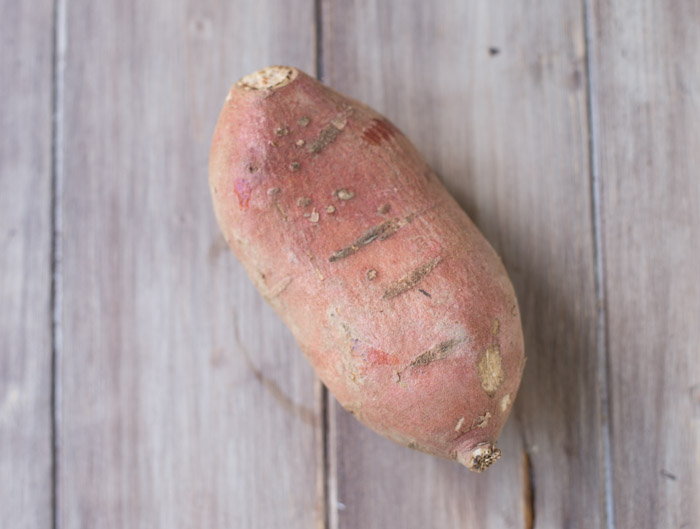
Use your spiralizer to sprialize the sweet potatoes. I used a hand-held sprializer, which was slightly difficult to use for a sweet potato. If you don’t own a spiralizer, you may use a julienne peeler to create sweet potato noodles. Hold the potato in one hand and slowly pull the julienne peeler down the potato with your other hand. Repeat this process until the entire sweet potato is “peeled”. NOTE: using a julienne peeler is a tedious process but it can be done.
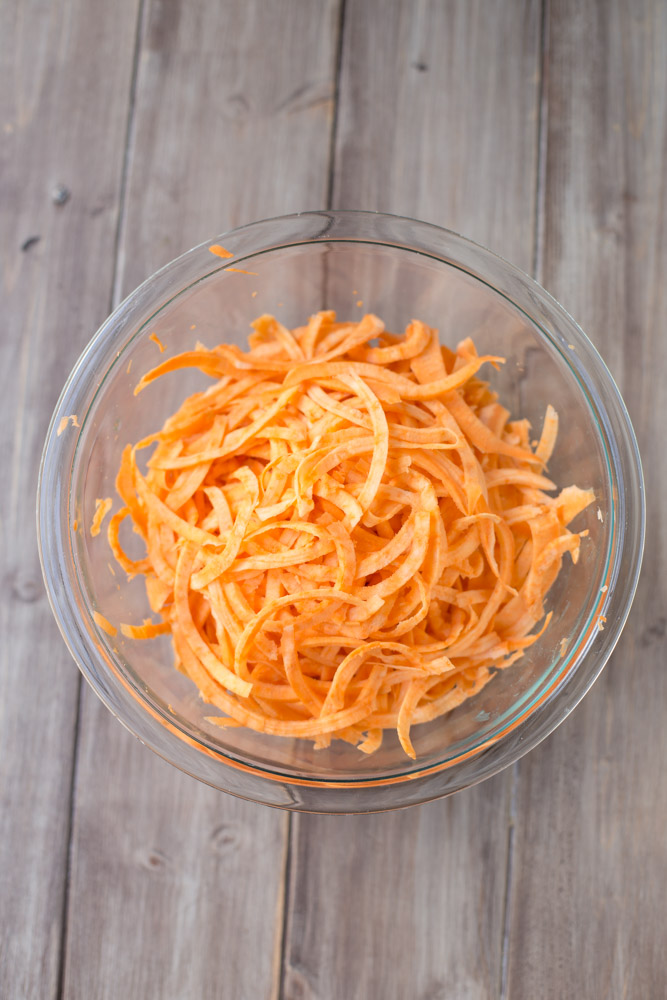
Cook the sweet potato noodles. Place 1 tbsp of extra virgin olive oil in a 10 inch skillet (I used cast iron but you may use stainless steel) and heat over medium high heat. Add the spiralized sweet potatoes and toss with tongs to coat with the olive oil. Continue to toss with the tongs every few seconds to prevent the potatoes from burning or becoming stuck on the bottom of the skillet. Do this for 5-10 minutes. The cooking time will depend on your preferred texture of the noodles. If you love a little crunch, cook for 5 minutes. If you prefer soft noodles, cook for 10. Sample a noodle to find out if it’s reached your preferred texture.
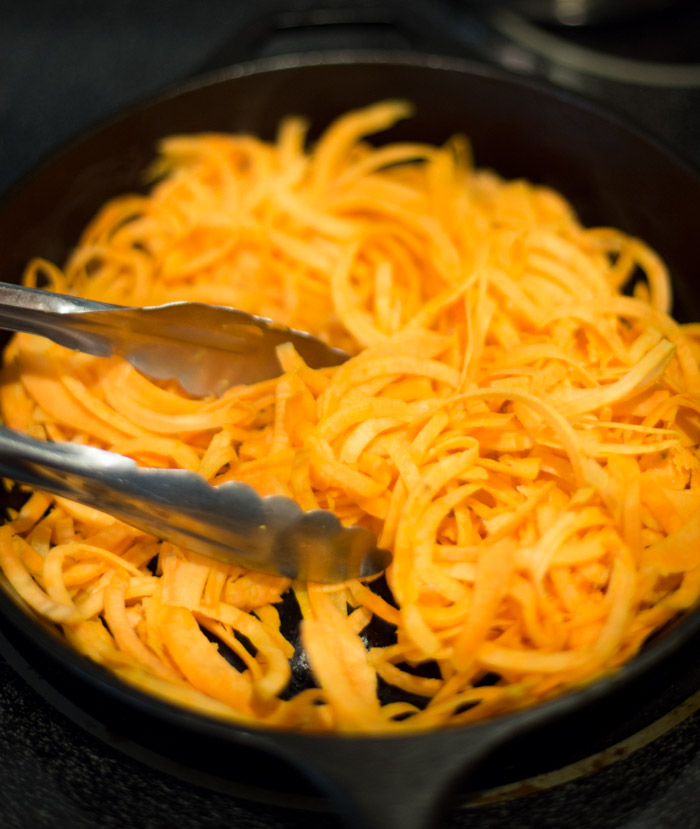
Once the noodles are done cooking, remove from heat and serve directly from the skillet or in serving bowls with whichever sauces or topping you prefer. 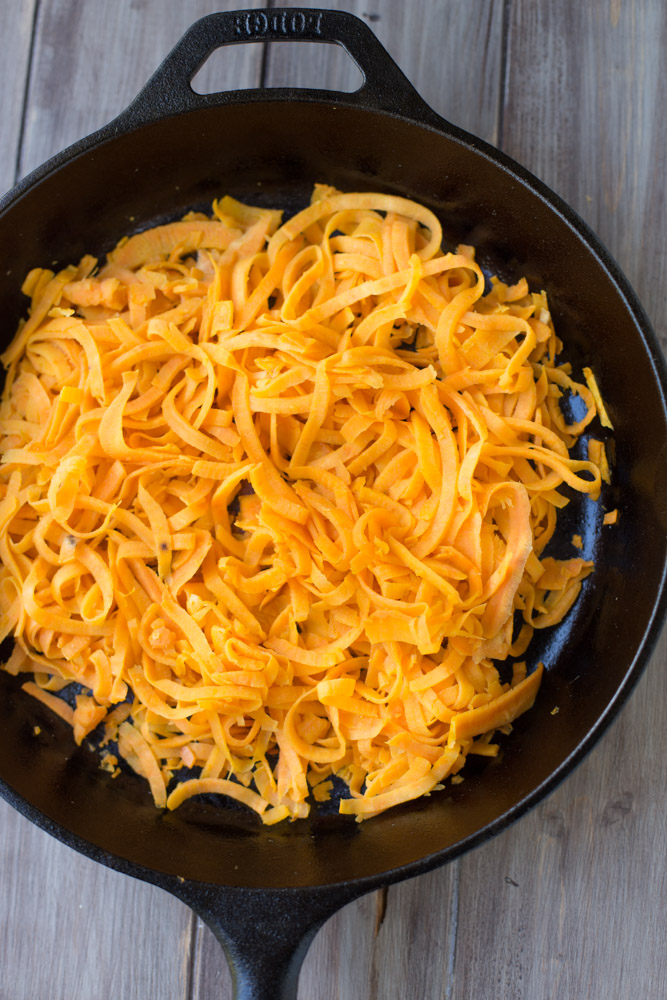
I topped the noodles with Spiced Braised Lentils (adapted from Food 52’s Genius Recipes cookbook; recipe will be shared on this blog soon).
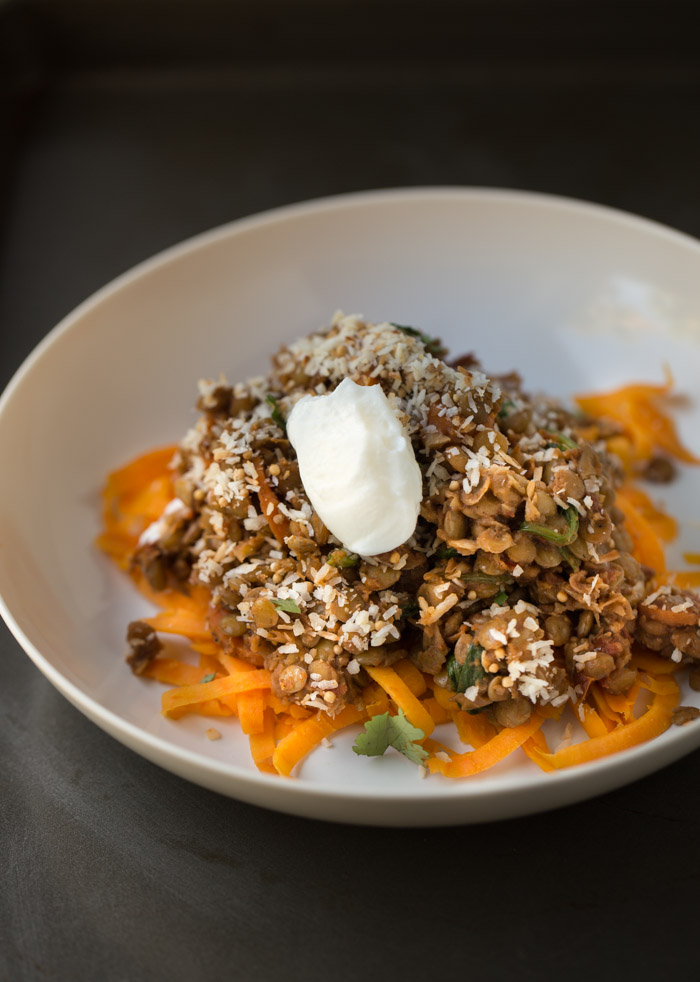
6 Common Mistakes to Avoid with Sweet Potato Noodles
Even though sweet potato noodles are simple to make, a few common mistakes can trip you up, especially if it’s your first time spiralizing or cooking them. Here’s what to watch out for so your noodles turn out tender, flavorful, and frustration-free.
1. Using the Wrong Size Potato
Sweet potatoes that are too thick or oddly shaped won’t spiralize easily. You’ll either end up having to cut them down and lose the long noodle effect, or worse, get halfway through spiralizing and have the potato jam or break. Always aim for firm, straight, medium-width sweet potatoes.
2. Not Drying the Noodles
After spiralizing, sweet potatoes can hold on to a bit of moisture. If you throw them straight into the pan wet, they’ll steam instead of sauté, and you’ll lose that nice bit of browning on the edges. Pat them dry with a clean towel or paper towel before cooking.
3. Skipping the Oil or Using the Wrong Pan
Sweet potato noodles need a slick surface to keep from sticking. A good amount of olive oil and a quality nonstick or well-seasoned cast iron skillet make all the difference. Stainless steel can work too, but you’ll need to monitor closely and keep things moving with tongs.
4. Overcrowding the Skillet
Too many noodles at once can cause uneven cooking or soggy results. If you’re making a big batch, cook them in two rounds so the pan stays hot and the noodles sauté rather than steam.
5. Overcooking Until Mushy
These noodles cook fast, usually in 5 to 10 minutes depending on how soft or crisp you like them. Go too long and they’ll lose structure and fall apart. Start checking for doneness around the 5-minute mark and keep tossing to cook evenly.
6. Forgetting to Taste and Adjust
Always taste before taking them off the heat. A pinch of salt, a little pepper, or a squeeze of lemon can completely change the flavor balance. Don’t be afraid to adjust on the fly once the noodles are almost done.
With just a little attention to detail, you’ll avoid the most common sweet potato noodle slip-ups and end up with a dish that’s flavorful, tender, and ready for any sauce or topping you throw at it.
How to Serve Sweet Potato Noodles
One of the best things about sweet potato noodles is how adaptable they are. Once you’ve spiralized and cooked them, you’ve got a naturally sweet, sturdy base that plays well with everything from bold sauces to delicate toppings. Here are some of my favorite ways to serve them, whether you’re building a full meal or just dressing up a side dish.
As a Pasta Swap
Use sweet potato noodles anywhere you’d use spaghetti or linguine. They’re excellent with:
- Marinara or tomato basil sauce
- Pesto with toasted pine nuts
- Creamy garlic Parmesan sauce
Keep in mind that because sweet potato noodles have their own mild sweetness, they work especially well with savory or spicy sauces to balance them out.
As a Breakfast Skillet Base
Toss the cooked noodles in a cast iron skillet and top with:
- A fried or poached egg
- Sliced avocado
- Crumbled bacon or turkey sausage
- A sprinkle of goat cheese or feta
This is one of my go-to weekend breakfasts. The sweet potatoes add a caramelized flavor that pairs beautifully with egg yolk and herbs.
In Grain-Free Bowls or Stir-Fries
For a quick lunch or dinner, try tossing the noodles with:
- A handful of sautéed greens like spinach or kale
- Cooked ground turkey or shredded rotisserie chicken
- A drizzle of tahini, peanut sauce, or even chipotle mayo
You can mix and match with what you have in the fridge. Leftovers work great here too.
With Spiced Braised Lentils (My Favorite)
One of my absolute favorite ways to serve sweet potato noodles is topped with spiced braised lentils. The earthiness of the lentils with the tender, slightly sweet noodles is pure comfort food. I first adapted this from Food52’s Genius Recipes and it’s been a regular in my rotation ever since.
Simple Flavor Add-Ons
If you want to keep things basic but still flavorful, try tossing your cooked noodles with:
- Garlic and fresh herbs
- Olive oil and lemon juice
- Chili flakes and lime zest
- Butter and cinnamon for a cozy, sweet-savory side
Whether you’re making a full dinner or just jazzing up leftovers, sweet potato noodles give you a base that’s flavorful enough to stand on its own and flexible enough to take on bold toppings and sauces.
The more you make them, the more ideas you’ll come up with. And once they’re in your weekly routine, you’ll start reaching for that spiralizer without even thinking about it.
Make-Ahead Tips and How to Store Leftovers
If you want to work sweet potato noodles into your weekly routine, a little prep ahead of time goes a long way. Here’s how to store, reheat, and even freeze them without turning them soggy or mushy.
Can You Spiralize Sweet Potatoes Ahead of Time?
Yes! You can spiralize sweet potatoes up to 2 days in advance. Store the raw noodles in an airtight container lined with a dry paper towel. This helps absorb any moisture and keeps them from getting slimy. Replace the paper towel if it gets damp.
If you’re prepping for a meal later in the day, you can also store the spiralized noodles in a large zip-top bag with the air pressed out. Just don’t wash them after spiralizing, as excess moisture can lead to sogginess.
How to Store Cooked Sweet Potato Noodles
Once cooked, let the noodles cool to room temperature, then transfer them to an airtight container. They’ll keep in the fridge for up to 3 to 4 days.
For best results, store them separately from any sauce or toppings so you can reheat the noodles evenly without overcooking anything else.
How to Reheat Sweet Potato Noodles
The best way to reheat is in a skillet over medium heat with a small splash of olive oil or water to loosen things up. Avoid microwaving if possible, since it tends to make the noodles soft and unevenly heated.
Stir gently and cook just until warmed through. Overheating will break them down and make them mushy.
Can You Freeze Sweet Potato Noodles?
- Raw noodles: Not recommended. They don’t thaw well and tend to break apart or turn gummy.
- Cooked noodles: You can freeze them, but they’re best used in soups or casseroles where texture isn’t as critical. Store in a freezer-safe bag or container for up to 2 months.
If you’re looking to add sweet potato noodles to meal prep, storing them raw for a few days or cooking fresh batches in small portions tends to give the best texture and flavor. With a few simple tricks, they’ll be ready whenever you need them.
Variations and Flavor Twists
Once you’ve mastered the basic sweet potato noodle, it’s easy to get creative with flavor and color. This humble root veggie is more versatile than most people give it credit for, and there are plenty of ways to switch things up.
Use Different Varieties of Sweet Potatoes
Most recipes use classic orange sweet potatoes, but you can branch out:
- Purple sweet potatoes have an earthy flavor and stunning color. They’re a little drier, so spiralize slowly.
- Japanese sweet potatoes (white flesh, purple skin) are sweeter and starchier, and they hold their shape beautifully in the skillet.
Each type has a slightly different texture, so experiment and see which one you like best for savory dishes, sweet dishes, or colorful bowls.
Blend in Other Veggies
For a colorful noodle blend, try spiralizing:
- Carrots
- Beets
- Zucchini
- Yellow squash
You can spiralize these raw and mix them with sweet potatoes for extra color, crunch, and nutrients.
Change Up the Oil and Seasonings
The type of oil you use can make a big difference:
- Olive oil for a classic Mediterranean flavor
- Ghee or clarified butter for richness (great for paleo)
- Coconut oil if you’re going for Thai- or Indian-style flavor
Pair your oil with seasoning blends like:
- Smoked paprika and cumin for a taco bowl
- Curry powder and garlic for an Indian twist
- Cinnamon and nutmeg for a slightly sweet side dish
- Chili flakes and lime zest for something bright and spicy
Finish with a Sauce
Sometimes all it takes to make sweet potato noodles feel new is the sauce:
- Tahini and lemon for something creamy and nutty
- Peanut sauce or almond butter dressing for an Asian-style bowl
- Balsamic glaze and crumbled goat cheese for a fall-inspired dish
Once you’ve got the cooking method down, these noodles become a blank canvas. Don’t be afraid to toss in leftovers, use up what’s in the fridge, or try a new seasoning combo that sounds good. Sweet potatoes play nice with bold flavors, and there’s no one right way to serve them.
FAQs About Sweet Potato Noodles
Here are some straightforward answers to the most common questions I receive about this sweet potato noodle recipe.
Do you need to peel sweet potatoes before spiralizing?
Yes, I recommend peeling them first. The skin of a sweet potato is edible, but it’s tough and can interfere with the spiralizing blades. Removing the skin helps your noodles come out cleaner and keeps the texture consistent. A simple vegetable peeler works just fine.
Can I bake sweet potato noodles instead of sautéing them?
You can, but you’ll want to keep an eye on them. Toss the raw noodles with olive oil and spread them in a single layer on a parchment-lined baking sheet. Bake at 400°F for about 10 to 15 minutes, flipping halfway through. They won’t be quite as soft or caramelized as the skillet version, but they’ll still work great in bowls or tossed with sauce.
Are sweet potato noodles healthy?
Absolutely. Sweet potatoes are packed with fiber, antioxidants, and beta-carotene. They’re lower on the glycemic index than white potatoes, and when you cook them simply with olive oil or ghee, they make a nourishing, nutrient-dense base for meals. They’re especially popular with paleo, Whole30, and gluten-free eaters.
How do you keep sweet potato noodles from getting soggy?
The biggest trick is avoiding too much moisture. Pat the raw noodles dry before cooking, and don’t overcrowd the skillet. Use medium-high heat and stir with tongs so they cook evenly without steaming. If they sit in the pan too long, they’ll soften more than you might like.
Can you make sweet potato noodles without a spiralizer?
Yes, but it takes a little more patience. A julienne peeler will give you short, ribbon-like noodles. Just hold the sweet potato in one hand and drag the peeler down in long strokes with the other. It’s slower and more hands-on, but the results are still delicious and work just fine in most recipes.
If you’re spiralizer-free, it’s a great way to try sweet potato noodles before committing to a new kitchen gadget.
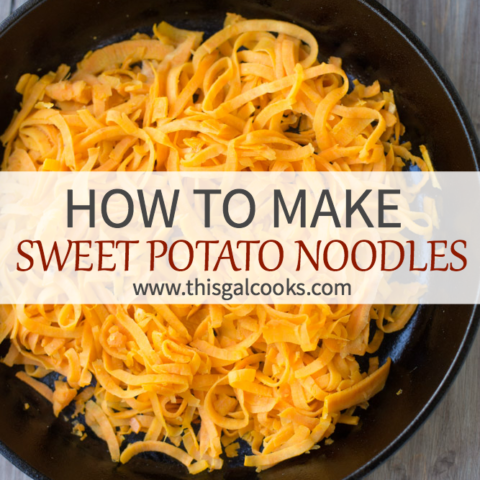
How to Make Sweet Potato Noodles
Ingredients
- 1 tbsp extra virgin olive oil
- 2 medium sweet potatoes (see notes for size)
- pinch of kosher salt
Instructions
- Use your spiralizer to sprialize the sweet potatoes. I used a hand-held sprializer, which was slightly difficult to use for a sweet potato. If you don't own a spiralizer, you may use a julienne peeler to create sweet potato noodles. Hold the potato in one hand and slowly pull the julienne peeler down the potato with your other hand. Repeat this process until the entire sweet potato is "peeled". NOTE: using a julienne peeler is a tedious process but it can be done.
- Cook the sweet potato noodles. Place 1 tbsp of extra virgin olive oil in a 10 inch skillet (I used cast iron but you may use stainless steel) and heat over medium high heat. Add the spiralized sweet potatoes and toss with tongs to coat with the olive oil. Continue to toss with the tongs every few seconds to prevent the potatoes from burning or becoming stuck on the bottom of the skillet. Do this for 5-10 minutes. The cooking time will depend on your preferred texture of the noodles. If you love a little crunch, cook for 5 minutes. If you prefer soft noodles, cook for 10. Sample a noodle to find out if it's reached your preferred texture.
- Once the noodles are done cooking, remove from heat and serve directly from the skillet or in serving bowls with whichever sauces or topping you prefer.
Notes
Choose thinner sweet potatoes as they will be easier to use in a spiralizer.
Nutrition Information:
Amount Per Serving: Calories: 65 Total Fat: 0g Sodium: 23mg Carbohydrates: 17g Sugar: 4g Protein: 1g
Try These Recipes Next
Looking for inspiration to use your sweet potato noodles? Try these cozy, nutrient-packed ideas from This Gal Cooks:
- Blackened Scallops with Sweet Potato Noodles
Seared scallops rest on a bed of creamy, dairy-free sweet potato noodles tossed with coconut milk, shallots, and garlic. It’s light, luxurious, and Whole30-friendly. - Tropical Sweet Potato Burrito Bowls
Build bright, flavorful bowls featuring cumin-seasoned sweet potatoes, cilantro-lime rice, and fresh pineapple salsa. All in one skillet for easy prep. - Spiced Lentils with Toasted Coconut + A Baby Shower!
These earthy lentils are perfect over hot sweet potato noodles. Flavored with garam masala, coconut, spinach, and carrots… pure comfort food.
Each dish highlights sweet potato noodles in fresh, delicious ways, from seafood to spice-forward bowls to protein-rich vegetarian bowls. Perfect pairings to follow your noodle prep success!

This is just brilliant, Julie! Can’t wait for the lentils recipe that goes along with!
I hope to get the lentil recipe up next week! It’s darn good and tastes great with the sweet potato noodles!
I have yet to try sweet potato noodles but I LOVE this!!! will give this a go soon!!! love!
Hope you enjoy the sweet potato noodles as much as I do, Alice!
These are super intriguing- I have yet to try veggie noodles but they look amazing and i love the color!
Thanks Medha! If you love veggies, I think you will adore veggie noodles. Hope you give them a try sometime soon. :)
Pingback: How To Cook Sweet Potato Vermicelli Noodles | well - done . cooking beef steaks
Pingback: How To Cook Sweet Potato Starch Noodles | sachimi - cooking sushi for beginners
Pingback: How To Cook Sweet Potato Starch Noodles | spinach -how to cook vegetables
Pingback: How To Cook Sweet Potato Vermicelli Noodles | sachimi - cooking sushi for beginners
Pingback: How To Cook Sweet Potato Starch Noodles | recipes - lets cook spaghetti
Pingback: How To Cook Sweet Potato Starch Noodles | book - how to cook
Pingback: How To Cook Sweet Potato Starch Noodles | pasta - lets cook spaghetti
Pingback: How To Sneak in Vegetables - Easy Lazy Paleo
Pingback: Getting an Abdominal Massage: My Experience – That RPCV Tho
Pingback: Spiced Lentils with Toasted Coconut + A Baby Shower! | This Gal Cooks
Pingback: 20 Best Sweet Potato Noodles Recipe - Best Recipes Ever